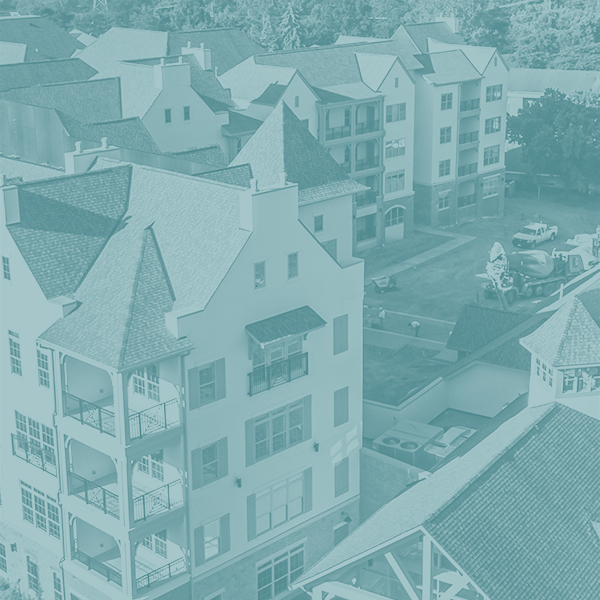The Boomers have done it again.
This generation has historically changed most industries, and senior living is + will be no different. As we look at the future of senior housing, we’d be remiss if we didn’t study the Baby Boomer generation and their wants + needs so that the facilities we’re planning today, and even 5-10 years from now, resonate with the soon-to-be unprecedented elder population.
While their preferred senior living accommodations are just beginning to be known, some trends are already on the horizon.
Senior living in urban locations
Historically, senior living communities cropped up in farmlands and other large areas with low density, but today we’re seeing more activity in urban locations. The active senior wants access to nearby amenities, healthcare + hotels, which can even be walkable from some sites, like downtown areas or near university campuses.
To make the urban sites with high price tags worthwhile, the structures must go vertical. Where the traditional senior community may top out at 2-4 stories, these may see 7 + beyond.
Structural implications of senior communities in urban locations are dependent on the construction material. A low to mid-rise structure is often constructed with wood. Wood design is at its best when walls are stacked from floor to floor, but the need for varying corridor widths and open amenity spaces often found on the ground level can result in an atypical framing plan, or mixed framing systems combining non-combustible framing with traditional wood construction. Mid to high-rise structures often rule out wood construction (although mass timber is changing this – click here to read more about going tall with wood). The team would review options like all cast-in-place concrete, precast plank + metal stud or CMU walls, concrete floors + metal stud walls, and all structural steel, taking into account owner requirements + cost considerations. None of those have the same challenge with stories that don’t stack like in wood construction, but they may need creative design to coordinate column + braced frame locations or economize the depths of the floor framing + steel tonnage, just to name a few.
Local restrictions affecting senior living development construction
A lot goes into a new senior living development and we’ve seen conflict begin as early as planning + zoning. Let’s face it – senior living campuses are big. Where it’s located, how it looks – yes, that’s up for debate and can affect construction budgets.
Building code + licensure options are not always consistent across states. Here’s an example:
- Ohio Building Code prefers Assisted Living as an I-1 Use which assumes occupants are capable (with limited assistance) of evacuating a building in an emergency. Per the OBC, an I-1 Use can be three-stories as Type V Construction.
- Assisted Living in Ohio is licensed by the Ohio Department of Health as a RCF (Residential Care Facility). It is under the jurisdiction of State Fire Marshal who uses Life Safety Code 101, which only permits an I-1 Use as a two-story structure in Type V Construction.
- Move this same scenario to Pennsylvania and the licensure of Assisted Living is a Personal Care Home which does not require compliance to LSC 101, meaning the building can be three-stories.
While some remain independent, senior living communities are often part of a chain, with sister locations within and/or crossing state lines. Differing building code requirements like what you read in the example above can be challenging for a single facility to navigate. Enter owners with retirement communities across a region, who want to develop a superior, prototyped design to use for their next ten sites. The design + construction team manage the differences, and we believe we’ll continue to see restrictions like these affect the future of senior housing design + site selection, and actually send the design team back to the drawing board for some sites.
The architect determines how the building will have to be constructed which explicitly drives the type of construction. Two commons considerations are that a building either needs to be non-combustible or a high structural importance factor. If the building has to be non-combustible, the structural engineer initiates a conversation with the architect + developer to make a determination as to the best + most efficient material to use at any particular site, as costs + familiarity vary by region. A higher structural importance factor results in increased design loads because the code deems a portion of the building to be a higher risk for the occupants.
Material shortages due to the COVID-19 pandemic have added an additional puzzle piece that won’t quite fit in the final design. For projects just kicking off, our team recommends a collaborative process from the very beginning so that structural designs can efficiently adapt to material fluctuations if necessary. For projects in the thick of it, we’re watching the market and altering or redesigning elements based on the owner’s timeline. Challenges like these call for a creative structural engineer who can balance owner needs + design intent with an eye on market trends, budget + timeline.
Building efficiency in senior living developments
Senior communities can offer a variety of services for a variety of needs. Some communities focus on one type of care while others have essentially built their own city where residents can transition based on their medical needs, from individual cottages to more involved care. Conversations are fluid as new research contemplates mixing residents across programs, where in the past it has been more siloed.
Siloed + mixed communities come across the same types of challenges listed above. Siloed communities may have several buildings on the same campus that all require a different standard of structural design. Mixed communities may also mix structural systems within the same building to be most efficient with their resources.
Every day, 10,000 adults turn 65 in the United States. It’s not a matter of if we need additional senior housing, but how long the increased market trend will last. We anticipate the senior community market to continue to be strong in the coming years, creating supportive + satisfying spaces for our grandparents, parents + ourselves.
Thanks to Michael Healy, AIA, Principal, pH7 Architects for sharing his expertise; his collaboration on senior living projects + this article is always most appreciated.



